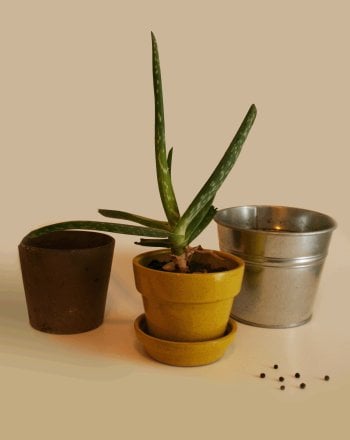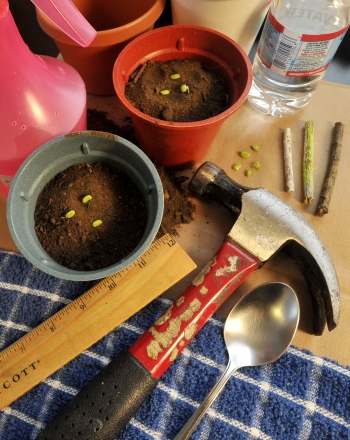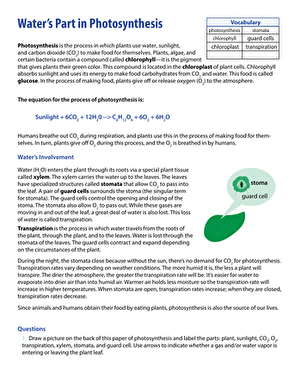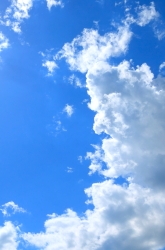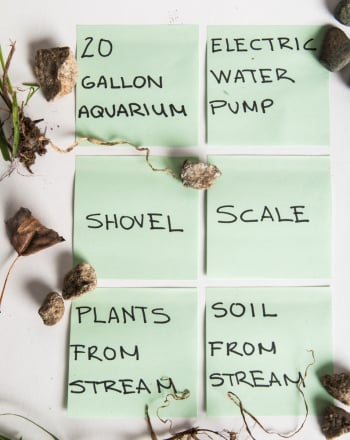Science project
What are the Effects of Light Intensity on the Rate of Photosynthesis and Oxygen Production in Plants?
Type
Grade Level
Middle School (Grades 6-8)
Difficulty of Project
Cost
Under $10.00 excluding the Tri-fold Display Board
Safety Issues
The investigator should be reminded to use matches safely. Once a match is used it should be discarded properly. If the investigator blows out a match and throws it in the trash, there is a danger that it might not be totally extinguished. To reduce this risk wet the used match head thoroughly with water than discard.
Material Availability
The materials required for this project are readily available.
Approximate Time Required to Complete the Project
2 Days
Objective
This project focuses on the production of oxygen by plants during the photosynthesis process. The research aspect of this science fair project is to assess how light intensity affects the rate at which photosynthesis occurs and the rate of oxygen production.
The project investigator will place a sprig of elodea (underwater) plant under a clear funnel then fill a test tube with water and it placed on top of the funnel. This entire setup will be placed in a larger container of water. A light source will be placed at different distances from the test plant. The gas given off in the form of bubbles will be collected in the test tube and tested for the presence of oxygen.
From the observations and tests made a data table will be generated and results displayed in the form of a graph.
Materials and Equipment / Ingredients
Elodea (water plant), light source (40 Watt bulb and socket), test tube (or long slider empty bottle), distilled water, tape, baking soda, a clear plastic funnel, thin piece of wood, metric ruler, and long stick matches.
With the possible exception of the elodea plant and a test tube, all the other items can be purchased from the local supermarket, hardware, homebuilding or big box retail (Wal-Mart, Target, etc) store. Also, a Tri-fold cardboard display board can be purchased from an art & crafts supply store.
The elodea underwater plants can be purchased from a pet supply store, and a test tube can be borrowed from a high school science teacher or found in a toy chemistry set.
Introduction
6CO2 + 6H2O C6H12O6 + 6O2
This equation simply means that carbon dioxide from the air and water combine in the presence of sunlight to form sugar and oxygen is released as a by-product of this reaction.
This test plant setup (See Figure 1) is placed in room with no light and then it will be exposed to light with varying degrees of intensity (based on distance). While exposed, the plants will produce a gas which is collected in an inverted test tube.

After enough gas has been produced and collected, the test tube will be removed, and inverted, and a glowing piece of wood is inserted into the tube. The wood should burn more rapidly in the oxygen gas in the test tube than in the air. The behavior of the glowing piece of wood will show that the gas produced by the plants is oxygen. The fact that no gas was produced while the setup was kept in the dark showed that light was the cause of the production of oxygen. The increases in bubbling (gas production) as the light source is moved closer to the plants indicate that the rate of oxygen production by the photosynthesis is affected by the intensity of the light source.
Digital photos can be taken during the experimenting process and the following websites offer down loadable images that can be used on the display board:
- http://tonto.eia.doe.gov/energyexplained/images/photosynthesis1.gif
- http://www.eoearth.org/files/121601_121700/121668/Irrigation-photosynthesis.gif
- http://www.vtaide.com/png/images/photosyn.jpg
- http://library.thinkquest.org/3715/photo3.html
Research Questions
- What isPhotosynthesis?
- During process of sugar production in this project carbon dioxide combines with water to form glucose sugar and what gas is released?
- Would this investigation have worked if a light source was not present?
- Does distance (intensity) of light from the planet increase the rate oxygen production?
Terms, Concepts and Questions to Start Background Research
Photosynthesis, chlorophyll, oxygen
Experimental Procedure
- Get a sprig of elodea. Remove several leaves from around the cut end of the stem. Slice off a portion of the stem at an angle and lightly crush the cut end of the stem.
- Place the plant under the funnel as shown and filled with water. Add a pinch of baking soda powder to the test tube. Then fill the test tube with water and place on top of the funnel as shown in figure 1 make sure there is no air in the test tube.

- Place this set-up in a darken room or closet for several hours, after the set time period has pasted check to see if gas has collected in the test tube.
- Next, place a light source 5 cm from the plant. After one minute, count and record the number of oxygen bubbles rising from the cut end of the stem. Count bubbles seen for five minutes.

- Move the lamp so it is 10 cm from the plant. After one minute count and record bubbles for five-minutes. Repeat the same procedure, but this time move the light source 15 cm away and count the bubbles seen. Record the results.
- Light a thin piece of wood with a match, and blow out the flame. Remove the test tube, invert it, and insert the glowing wooden splint into the test tube as shown to the left. Note any evidence of it re-lighting.
|
Distance of light source |
5 cm |
10 cm |
15 cm |
|
Number of bubbles |
|
|
|
- Using graph paper or a computer equipped with Excel® visually display the data in the table by plotting a bar or line graph showing the rate of oxygen production along the vertical (Y) axis verses the distance of the light source along the horizontal (X) axis.
Bibliography
Title: Photosynthesis, Authors: David O. Hall and Krishna Rao, Publisher: Cambridge University Press, ISBN-10: 0521644976 ISBN-13: 978-0521644976
- The Production of Oxygen in Photosynthesis http://www.jgsee.kmutt.ac.th/exell/JEE613/WriteExptExample.html
- Types of Photosynthesis http://wc.pima.edu/Bfiero/tucsonecology/plants/plants_photosynthesis.htm
Note: The Internet is dynamic; websites cited are subject to change without warning or notice!
Education.com provides the Science Fair Project Ideas for informational purposes only. Education.com does not make any guarantee or representation regarding the Science Fair Project Ideas and is not responsible or liable for any loss or damage, directly or indirectly, caused by your use of such information. By accessing the Science Fair Project Ideas, you waive and renounce any claims against Education.com that arise thereof. In addition, your access to Education.com's website and Science Fair Project Ideas is covered by Education.com's Privacy Policy and site Terms of Use, which include limitations on Education.com's liability.
Warning is hereby given that not all Project Ideas are appropriate for all individuals or in all circumstances. Implementation of any Science Project Idea should be undertaken only in appropriate settings and with appropriate parental or other supervision. Reading and following the safety precautions of all materials used in a project is the sole responsibility of each individual. For further information, consult your state's handbook of Science Safety.






